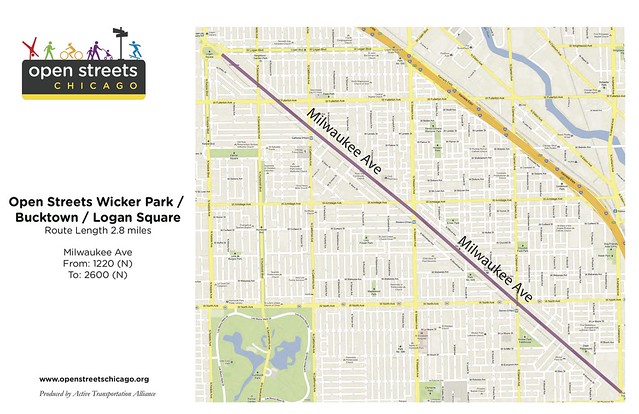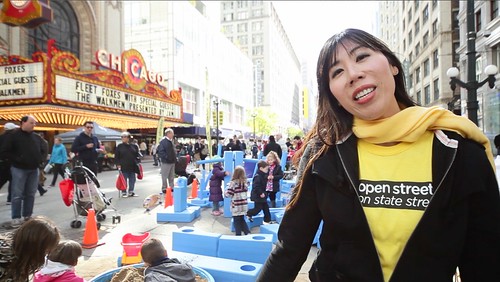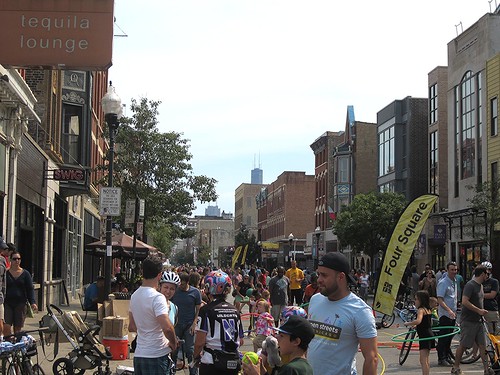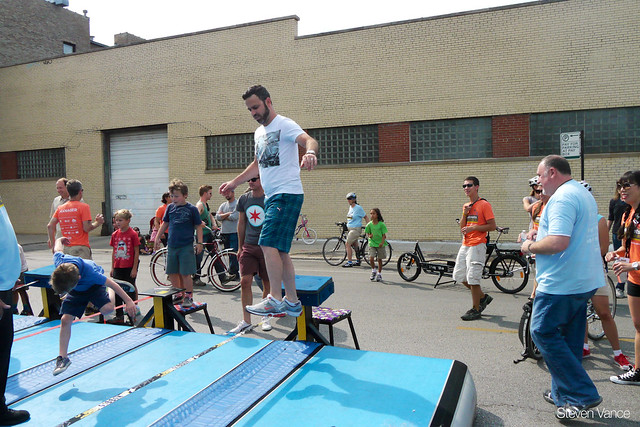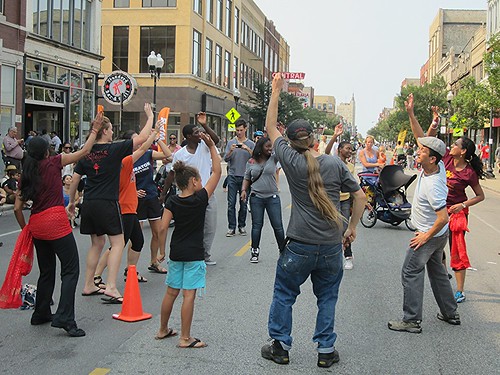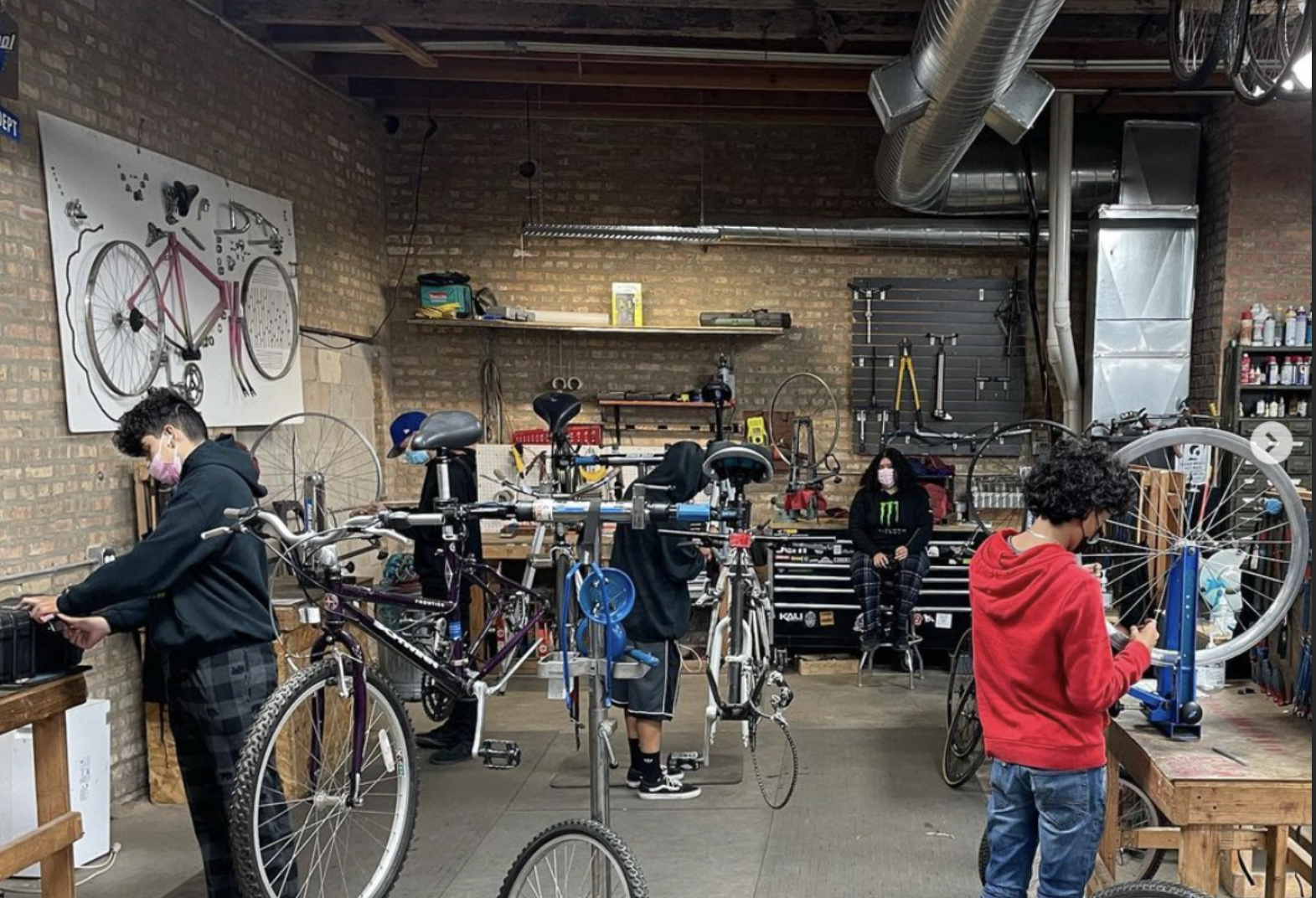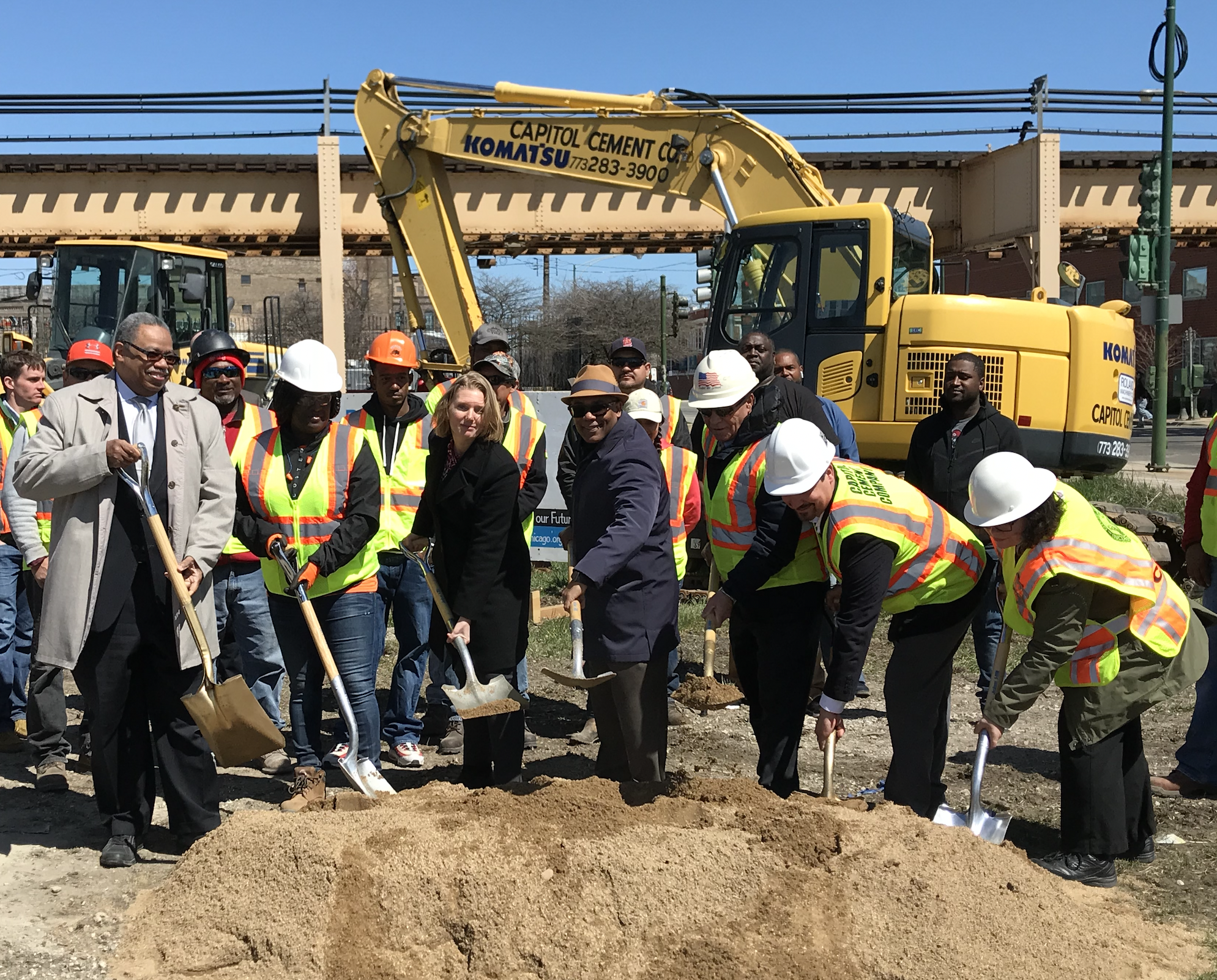Three Miles of Milwaukee Will Be Open for Car-Free Play This September
12:51 PM CDT on July 26, 2013
Although Chicago was one of the first U.S. cities to consider staging a ciclovía, a Latin-American-style event that creates temporary car-free street space in order to encourage healthy recreation, community interaction and commerce, we’re currently way behind peer cities. New York, Los Angeles, Portland, Oregon, and San Francisco are each hosting several ciclovía events this year on routes that are several miles long. Meanwhile Chicago will be hosting one event, called Open Streets, on Sunday, September 15, from 10 a.m. to 3 p.m., on a 2.6-mile stretch of Milwaukee Avenue between Division Street and Kedzie Boulevard in Wicker Park, Bucktown and Logan Square.
The main reason the ciclovía movement hasn’t caught fire in Chicago like it has elsewhere is political will. While those other cities have had mayors who have championed their car-free events and spearhearded planning and funding efforts, Chicago, even under the current pro-sustainable transportation administration, has not. Instead, for years the Active Transportation Alliance has taken responsibility for organizing and raising money for Open Streets, a challenging task.
In 2008 and 2009 Active Trans staged ciclovías along the boulevard system from Little Village to Logan Square. Due to funding problems, the event lay fallow in 2010. In 2011 Open Streets took place as a single event on State Street in the Loop, and last year it expanded to also include a route on Milwaukee from Ashland to Western Avenues. All of these ciclovías were joyful affairs, with thousands of Chicagoans of all stripes coming out to stroll, jog, pedal, play, dance and relax on car-free streets.
This year Active Trans proposed staging Open Streets in several neighborhoods, including routes in the Loop; from Pilsen to Little Village; from Wicker Park to Logan Square; and from Lincoln Park to Lincoln Square. Unfortunately, funding only materialized for the Northwest Side event. However, in a recent conversation about the event, Active Trans’ Open Streets Director Julia Kim argued this year was a breakthrough because Chicago Department of Transportation officials successfully lobbied to waive city fees for traffic management. She promised that this will be Chicago’s most successful ciclovía yet.
John Greenfield: The main issue with Open Streets has been funding and participation from the city. Previously it has been privately funded, with Active Trans raising all the money. You had to pay for the police and traffic aides, for example.
Julia Kim: Yup. Last year it was still privately funded, meaning we raised all the money to bring Open Streets, and we did not get financial support from the city for the street closures.
JG: What kind of support did you get from the city last year?
JK: [CDOT Commissioner] Gabe Klein and [Deputy Commissioner] Scott Kubly championed it and helped us with the logistics. CDOT would like to see it as a citywide event. So it was like, “Let’s make sure that you get the routes that you need.” So it was more of an endorsement.
JG: What’s different this year, with the city’s role?
JK: This year, again, championed by Gabe and Scott, the city is coming through with funding to pay for the street closure, meaning staffing and barricades. So that enables us to actually extend the Milwaukee route all the way to Logan Square.
I’m super-excited about it. The challenges are still there with funding. But it’s great, because with the city coming in to support us with the street closures, along with $40,000 in seed money from Wicker Park Bucktown SSA #33, we’re actually able to do one this year – for a while that wasn’t a sure thing. [An SSA or Special Service Area, is a designated district with an additional property tax which funds enhanced services and special events. Streetsblog’s Steven Vance is a member of the SSA #33 transportation committee.]
So we’d like to see more events, but because of the funding challenges we had this year, we’re doing one. That said, this one is actually double in length - it’s nearly three miles.
JG: What were the issues with funding this year?
JK: In other cities like Los Angeles and New York, the city takes a leadership role in organizing the event and pays for the street closure. In Chicago, we’re inching our way there. For the first time ever, the city is coming in to support the street closure with dollars, with staffing and city barricades.
That said, that funding didn’t come in until relatively late. So, in terms of finding sponsors, it was almost like we were selling air because you have to have a certain level of certainty, saying “This is the route and these are the days.”
This year with the Chicago Loop Alliance [one of the downtown Chambers of commerce, the main funder of Open Streets on State Street], because of their budget structure and because of a personnel change - they have a new executive director - and their budget cuts from their SSA, they weren’t able to provide the same funding as last year. That put us in a much more challenging position.
JG: So that’s why there’s no Loop event.
JK: Right. The funding that they were able to produce just wasn’t enough. We’re definitely in talks for next year. As you know, in the past Open Streets on State Street was measured as being successful.
JG: What was the attendance for the two events last year?
JK: Roughly 45,000 altogether. About 25,000 downtown, because we added Monroe Street as an extension to the route. Plus it was the second year, so that helped attendance. For Wicker Park, it was an overwhelming success in terms of how many people turned out. And so, working with the police, we roughly estimated that at 20,000 people.
This year, with a longer route, we hope to grow that attendance. Because not only are we getting the Wicker Park / Bucktown corridor, we’re also getting Milwaukee all the way up to Logan Square, which is a nice bike route. We’re in the process of planning programming. We have a few sponsorships that we are close to signing, so I don’t want to talk too much about them, but we’re hoping to get Walgreens back onboard.
JG: There has been talk for years now about trying to get Open Streets back into low-income neighborhoods. So is that ever going to happen? What’s the strategy?
JK: You know, John, we’d love to see it happen citywide and have multiple routes and do at least three to seven events. I think the dream goal was to see seven happening in different neighborhoods, throughout the year. But it really comes down to funding.
JG: Chicago has been doing many things well in terms of sustainable transportation and public space initiatives lately, so why is the ciclovía the one thing that has not been going smoothly in Chicago?
JK: I think it’s going as well as it can, insofar as the mini steps of getting where we want to go. It really comes down to the mayor’s endorsement and the city making the commitment, saying, hey, we’re going to carve out an investment to roll out Open Streets on a consistent, regular basis.
JG: I guess one way to look at it is the city has been lining up funding for a lot of good projects, and I guess they can’t do everything.
JK: Yeah. And I think it takes time. We’re a step closer this year versus last year.
JG: How so? Arguably it’s a step back, since there’s only one event.
JK: But it’s a step closer because the city’s coming in and actually supporting it. Next year we’d like to see if we can get the commitment from the city and have them say, “OK, we’re going to commit to funding three days of city staffing and street closures, and we can do these dates and routes.” That way when we start making pitches for sponsorship dollars we could say, “These are the Open Streets routes and these are the dates, so here’s what we’re proposing that you fund.”
JG: Do you know anything about the programming for this year’s event yet?
JK: Yeah, we’re going to bring back what we had last year, which was highly successful. So we’re reaching out to our vendors, including community businesses like CorePower Yoga. So we’ll have yoga, and we’ll have our Imagination Playground with giant building blocks.
What’s different this year than last year is that we’re going to have a hub concept, meaning the programming will be on the side streets, adjacent to the major drag, to make it easier to bike. We anticipate a lot of people on bikes, so this way Milwaukee will be wide open.
JG: Boy, I bet the pedicabbers are going to be all over this.
JK: Yeah, and we want to invite them to show up. [Logan Square’s] Revolution Brewing is onboard. [Owner Josh Deth] has always had a great interaction with the community. They’re going to have a beer garden, but we’ll work with them to make sure there’s a good balance, so that it will be a safe and fun addition.
One thing we learned from last year is that local businesses want to do more to promote themselves, because they do have the opportunity of leveraging all that additional foot traffic. So we’ve secured a sidewalk permit from the city so that merchants along the route will free to promote their businesses on the sidewalk.
JG: What will some of the other programming be this year? Are you going to have Bollywood dancing again?
JK: Absolutely. Everyone who was in last year, we’re inviting them all back. Playworks [a nonprofit that promotes physical activity in the schools] will be back with four square and other games. People love them.
JG: Will there be a slack line demo?
JK: REI is not in this year as a sponsor, so there will be no slack line or climbing wall. The skate park is a maybe, depending on what we work out with Uprise skate shop and sponsors. Last year that was sponsored by the Illinois Center for Broadcasting in the Loop and Wicker Park Bucktown for the Milwaukee Avenue corridor, but they’re not coming in with the dollars this year. Either way, the skate culture will definitely still be there, because the skaters would not want to miss out on this opportunity.
The route itself is just a perfect combination of mixed uses: residences, independent retailers, and even some big-box stores. You also have Damen Avenue, which is a huge retail Mecca, and there are also a lot of businesses along North Avenue. We’ll also be reaching out the Humboldt Park neighborhood. We’d love the Humboldt Park community to come out – it’s not that far.
You know there are two Divvy bike-share stations on this stretch of Milwaukee. We want to do something fun like a Divvy “slow race.” I think Scott Kubly wanted to do a Divvy skivvy race. I told him, you go first.
In addition to editing Streetsblog Chicago, John writes about transportation and other topics for additional local publications. A Chicagoan since 1989, he enjoys exploring the city on foot, bike, bus, and 'L' train.
Stay in touch
Sign up for our free newsletter
More from Streetsblog Chicago
Communities United: Reports of Bikes N’ Roses’ death have been greatly exaggerated
According to the nonprofit shop's parent organization, BNR has paused its retail component, but is still doing after school programming and looking for new staff.
Pressure is mounting to replace embattled CTA President Dorval Carter
Here's a look at what elected officials and other media outlets have said about the issue recently.
Service boost means BNSF Line will get Metra’s first-ever across-the-board weekend schedule, starting April 29
In addition, Halsted Street station will get weekend service, and Downers Grove's Fairview stop will become an off-peak stop.
